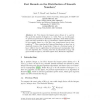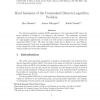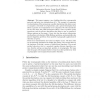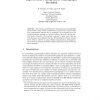ANTS
2006
Springer
15 years 4 months ago
2006
Springer
Let P(n) denote the largest prime divisor of n, and let (x, y) be the number of integers n x with P(n) y. In this paper we present improvements to Bernstein's algorithm, whi...
113
click to vote
ANTS
2006
Springer
15 years 4 months ago
2006
Springer
Despite their popularity, lattice reduction algorithms remain mysterious in many ways. It has been widely reported that they behave much more nicely than what was expected from the...
136
click to vote
ANTS
2006
Springer
15 years 4 months ago
2006
Springer
The discrete logarithm problem (DLP) generalizes to the constrained DLP, where the secret exponent x belongs to a set known to the attacker. The complexity of generic algorithms f...
ANTS
2006
Springer
15 years 4 months ago
2006
Springer
This paper suggests a new building block for cryptographic protocols and gives two instantiations of it. The concept is to generate two descriptions of the same group: a public des...
ANTS
2006
Springer
15 years 4 months ago
2006
Springer
Let E be an elliptic curve over the rationals. A crucial step in determining a Mordell-Weil basis for E is to exhibit some positive lower bound > 0 for the canonical height ^h ...
ANTS
2006
Springer
15 years 4 months ago
2006
Springer
Abstract. Tabulating elliptic curves has been carried out since the earliest days of machine computation in number theory. After some historical remarks, we report on significant r...
ANTS
2006
Springer
15 years 4 months ago
2006
Springer
ANTS
2006
Springer
15 years 4 months ago
2006
Springer
The security and performance of pairing based cryptography has provoked a large volume of research, in part because of the exciting new cryptographic schemes that it underpins. We ...
ANTS
2006
Springer
15 years 4 months ago
2006
Springer
Abstract. We describe the invariants of plane quartic curves -- nonhyperelliptic genus 3 curves in their canonical model -- as determined by Dixmier and Ohno, with application to t...
ANTS
2006
Springer
15 years 4 months ago
2006
Springer
We propose a practical sampling reduction algorithm for lattice bases based on work by Schnorr [1] as well as two even more effective generalizations. We report the empirical behav...




